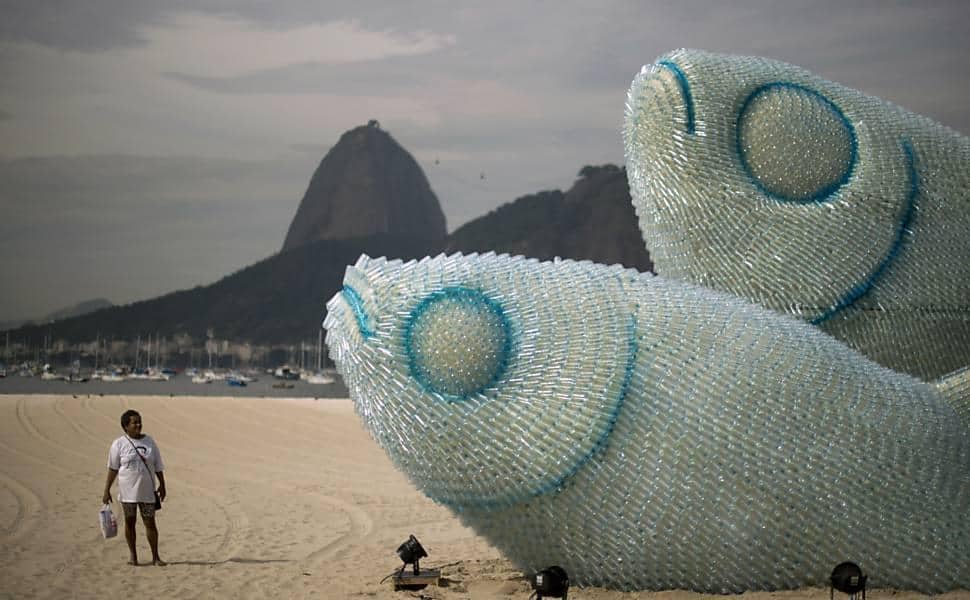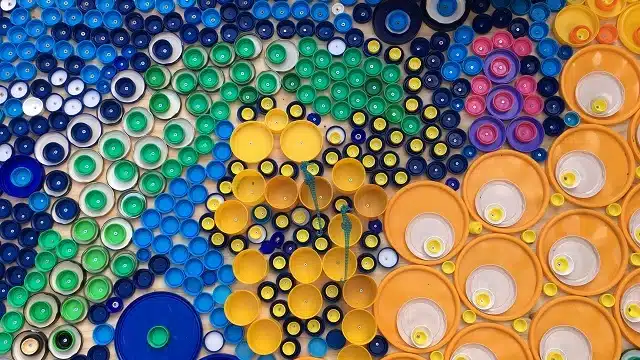Sustainable Art: Eco-Conscious Practices for Artists

Sustainable art focuses on using eco-friendly materials, promoting environmental awareness, and addressing social and ecological issues, contributing to a more conscious and responsible approach to artistic creation and consumption.
From Waste to Wonder: How to Turn Recyclables into Stunning Art Pieces
Recycling is a crucial practice that helps protect the environment and conserve valuable resources. By reusing materials instead of throwing them away, we can reduce waste and minimize our impact on the planet. However, recycling doesn’t have to be limited to simply separating our trash into different bins. It can also be a creative and sustainable way to turn waste into art.
The idea of turning waste into art is not only visually appealing but also promotes sustainability. By using recyclable materials in art, we can give new life to items that would otherwise end up in landfills. This not only reduces waste but also encourages others to think creatively about how they can repurpose everyday objects.
The Benefits of Turning Waste into Art
Creating art from recyclables offers numerous benefits. First and foremost, it helps reduce waste and promote sustainability. Instead of throwing away materials, we can transform them into something beautiful and meaningful. This not only saves resources but also raises awareness about the importance of recycling.
Using recycled materials in art also adds a unique and creative aspect to the artwork. Each piece becomes a conversation starter, as viewers are intrigued by the materials used and the story behind them. It challenges traditional notions of what art should be made from and opens up new possibilities for creativity.
Materials to Use: A Guide to Recyclables
When it comes to creating art from recyclables, the possibilities are endless. Here are some common recyclable materials that can be used in art:
1. Paper: Old newspapers, magazines, and cardboard can be transformed into collages, papier-mâché sculptures, or even woven baskets.
2. Plastic: Plastic bottles, containers, and packaging can be melted down and molded into new shapes or used as a medium for painting.
3. Glass: Broken glass can be used to create stunning mosaics or fused together to make unique sculptures or jewelry.
4. Metal: Scrap metal can be welded together to create sculptures or used as a canvas for painting.
5. Textiles: Old clothing, fabric scraps, and even discarded upholstery can be repurposed into quilts, rugs, or textile art.
Each material has its own unique properties and characteristics that can be explored and utilized in different ways.
Preparing Your Materials: Cleaning and Sorting
Before using recyclable materials in art, it’s important to properly clean and sort them. This ensures that the materials are safe to handle and free from any contaminants. Here are some tips and techniques for cleaning and sorting different materials:
1. Paper: Remove any staples or tape from paper before using it in art. If the paper is dirty or stained, you can try gently wiping it with a damp cloth or sponge.
2. Plastic: Rinse plastic containers and bottles with warm water and soap to remove any residue. For stubborn stains, you can soak them in a mixture of water and vinegar.
3. Glass: Clean glass pieces with warm soapy water and a soft cloth. Be careful when handling broken glass and use gloves to protect yourself from cuts.
4. Metal: Use a wire brush or sandpaper to remove any rust or dirt from metal objects. If the metal is painted, you may need to strip the paint before using it in art.
5. Textiles: Wash fabric scraps and clothing in the washing machine with mild detergent. If the fabric is delicate or requires special care, consider hand washing or dry cleaning.
By taking the time to clean and sort your materials, you ensure that your artwork is not only visually appealing but also safe to handle.
Techniques for Creating Art from Recyclables
There are various techniques that can be used to create art from recyclables, depending on the desired outcome and the materials being used. Here are some examples:
1. Sculpture: Sculpting with recyclables allows you to create three-dimensional art pieces. You can use materials such as metal, plastic, or paper to shape and assemble your sculpture. Welding, gluing, or folding techniques can be used to join the materials together.
2. Painting and Decorating: Adding color and texture to recyclable materials can transform them into unique works of art. Plastic bottles can be painted with acrylics, while paper can be collaged or painted on. Textiles can be dyed or embroidered to add visual interest.
3. Mosaic: Creating mosaics from recycled glass and ceramic is a popular technique that allows you to create stunning patterns and designs. Broken glass or ceramic pieces can be arranged and glued onto a surface to create a mosaic artwork.
Each technique offers its own set of challenges and opportunities for creativity. Experimenting with different techniques can help you discover new ways to repurpose recyclable materials.
Sculpture: Making Three-Dimensional Art Pieces
Sculpture is a versatile medium that allows artists to create three-dimensional art pieces using recyclable materials. Here are some tips and techniques for shaping and assembling different materials:
1. Metal: If you’re working with scrap metal, you may need to use welding techniques to join the pieces together. This requires proper safety precautions and equipment. Alternatively, you can use wire or metal fasteners to connect the pieces without welding.
2. Plastic: Plastic bottles and containers can be cut, shaped, and joined together using heat or adhesives. Heat guns or hot water can be used to soften the plastic, making it easier to mold into desired shapes.
3. Paper: Papier-mâché is a popular technique for creating sculptures using paper. Tear or cut the paper into small pieces and soak them in a mixture of water and glue. Layer the soaked paper onto a base structure, such as a wire frame, and allow it to dry. Once dry, the paper will harden and can be painted or decorated.
Experimenting with different techniques and materials can help you create unique and visually striking sculptures.
Painting and Decorating: Adding Color and Texture
Adding color and texture to recyclable materials can transform them into visually appealing art pieces. Here are some tips and techniques for painting and decorating different materials:
1. Plastic: Plastic bottles, containers, or packaging can be painted with acrylics or spray paint. Before painting, make sure to clean the plastic surface thoroughly to ensure proper adhesion. You can also add texture by using stencils, sponges, or textured paints.
2. Paper: Paper can be painted with watercolors, acrylics, or even ink. Collaging techniques can also be used to add texture and visual interest to paper artworks. Consider using different types of paper, such as tissue paper or newspaper, to create unique effects.
3. Textiles: Fabric scraps or clothing can be dyed using fabric dyes or natural dyes made from plants. You can also use fabric paints or markers to add designs or patterns to textiles. Embroidery or appliqué techniques can be used to add texture and dimension to fabric artworks.
Experimenting with different painting and decorating techniques can help you create vibrant and visually appealing art pieces.
Mosaic: Creating Stunning Patterns with Glass and Ceramic
Creating mosaics from recycled glass and ceramic is a popular technique that allows you to create stunning patterns and designs. Here are some tips and techniques for cutting and arranging different materials:
1. Glass: Broken glass pieces can be cut into desired shapes using glass cutters or tile nippers. Arrange the glass pieces on a surface, such as wood or concrete, and glue them down using mosaic adhesive or grout. Once the adhesive is dry, you can fill in the gaps between the glass pieces with grout.
2. Ceramic: Broken ceramic pieces, such as tiles or plates, can be cut into desired shapes using tile nippers or a wet saw. Arrange the ceramic pieces on a surface and glue them down using mosaic adhesive or grout. Like with glass mosaics, you can fill in the gaps with grout.
Experimenting with different colors and shapes of glass and ceramic can help you create visually striking mosaic artworks.
Upcycling: Transforming Trash into Functional Art
Upcycling is the process of transforming waste materials into new products of higher value or quality. It involves repurposing discarded items and turning them into functional art pieces. Here are some examples and inspiration for upcycling different materials:
1. Furniture: Old wooden pallets can be transformed into unique and rustic furniture pieces, such as tables or shelves. Discarded tires can be turned into ottomans or planters.
2. Lighting: Empty glass bottles can be transformed into pendant lights or table lamps. Old mason jars can be turned into candle holders or hanging lanterns.
3. Home Decor: Discarded wine corks can be glued together to create coasters or bulletin boards. Empty tin cans can be painted and used as vases or pencil holders.
Upcycling not only reduces waste but also allows you to create functional and visually appealing art pieces for your home.
Examples of Recyclable Art: Inspiration for Your Next Project
There are countless examples of recyclable art that can inspire your next project. From large-scale sculptures made from scrap metal to intricate mosaics created from broken glass, the possibilities are endless. Here are some examples to get your creative juices flowing:
1. Trash Animals by Bordalo II: Portuguese artist Bordalo II creates large-scale animal sculptures using discarded materials, such as car parts, tires, and scrap metal. His artworks raise awareness about the impact of waste on the environment.
2. Plastic Bottle Chandelier by Michelle Brand: British artist Michelle Brand creates stunning chandeliers using recycled plastic bottles. The bottles are cut into flower-like shapes and arranged to create a beautiful and eco-friendly lighting fixture.
3. Glass Mosaic Murals by Isaiah Zagar: American artist Isaiah Zagar is known for his intricate and colorful mosaic murals. He uses broken ceramic tiles, glass bottles, and other found objects to create stunning works of art that transform public spaces.
These examples showcase the power of creativity and sustainability in creating art from recyclables.
The Power of Creativity and Sustainability
Creating art from recyclables is not only visually appealing but also promotes sustainability and raises awareness about the importance of recycling. By repurposing waste materials, we can reduce waste, conserve resources, and contribute to a more sustainable future.
Whether you choose to create sculptures, paintings, mosaics, or functional art pieces, the possibilities are endless. By embracing your creativity and thinking outside the box, you can transform everyday objects into something beautiful and meaningful.
So next time you’re about to throw something away, think twice. Consider how you can repurpose it into a work of art instead. By doing so, you not only contribute to a more sustainable future but also unleash your creativity and create something truly unique.
Originally posted 2024-02-29 14:38:41.



